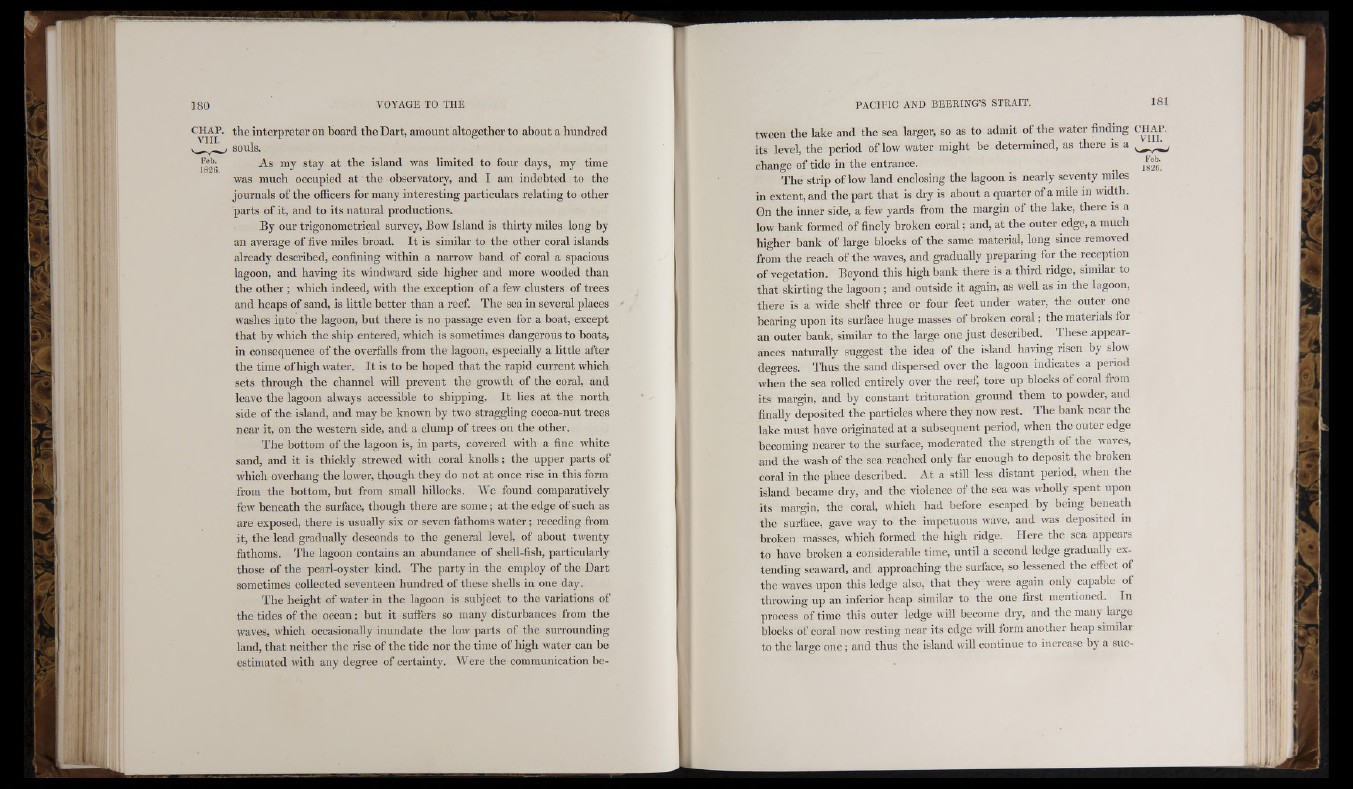
180
CHAP. the interpreter on board the Dart, amount altogether to about a hundred
Feb.
1826.
souls.
As my stay at the island was limited to four days, my time
was much occupied at the observatory, and I am indebted to the
journals of the officers for many interesting particulars relating to other
parts of it, and to its natural productions.
By our trigonometrical survey. Bow Island is thirty miles long by
an average of live miles broad. It is similar to the other coral islands
already described, confining within a narrow band of coral a spacious
lagoon, and having its windward side higher and more wooded than
the other ; which indeed, with the exception of a few clusters of trees
and heaps of sand, is httle better than a reef The sea in several places
washes into the lagoon, but there is no passage even for a boat, except
that by w-hich the ship entered, which is sometimes dangerous to boats,
in consequence of the overfalls from the lagoon, especially a little after
the time of high water. It is to be hoped that the rapid current which
sets through the channel will prevent the growth of the coral, and
leave the lagoon always accessible to shipping. It lies at the north
side of the island, and may be known by two straggling cocoa-nut trees
near it, on the western side, and a clump of trees on the other.
The bottom of the lagoon is, in parts, covered with a fine white
sand, and it is thickly strewed with coral knolls ; the upper parts of
which overhang the lower, though they do not at once rise in this form
from the bottom, but from small hillocks. YVe found comparatively
few beneath the surface, though there are some ; at the edge of such as
are exposed, there is usually six or seven fathoms water ; receding from
it, the lead gradually descends to the general level, of about twenty
fathoms. The lagoon contains an abundance of shell-fish, particularly
those of the pearl-oyster kind. The party in the employ of the Dart
sometimes collected seventeen hundred of these shells in one day.
The height of water in the lagoon is subject to the variations of
the tides of the ocean ; but it suffers so many disturbances from the
waves, which occasionally inundate the low parts of the surrounding
land, that neither the rise of the tide nor the time of high water can be
estimated with any degree of certainty. YVere the communication be-
tween the lake and the sea larger, so as to admit of the water finding CHAP.
its level, the period of low water might be determined, as there is a
change of tide in the entrance.
Feb.
1826.
The strip of low land enclosing the lagoon is nearly seventy miles
in extent, and the part that is dry is about a quarter of a mile in width.
On the inner side, a few yards from the margin of the lake, there is a
low bank formed of finely broken coral ; and, at the outer edge, a much
higher bank of large blocks of the same material, long since removed
from the reach of the waves, and graduaUy preparing for the reception
of vegetation. Beyond this high bank there is a third ridge, similar to
that skirting the lagoon ; and outside it again, as well as in the lagoon,
there is a wide shelf three or four feet under water, the outer one
bearing upon its surface huge masses of broken coral ; the materials for
an outer bank, similar to the large one just described. These appearances
naturally suggest the idea of the island having risen by slow
degrees. Thus the sand dispersed over the lagoon indicates a period
when the sea rolled entirely over the reef, tore up blocks of coral from
its margin, and by constant trituration ground them to powder, and
finally deposited the particles w here they now rest. The bank near the
lake must have originated at a subsequent period, w-hen the outer edge
becoming nearer to the surface, moderated the strengtli of the waves,
and the wash of the sea reached only far enough to deposit the broken
coral in the place described. At a still less distant period, when the
island became dry, and the violence of the sea was wholly spent upon
its margin, the coral, which had before escaped by being beneatli
the surface, gave way to the impetuous wave, and was deposited in
broken masses, which formed the high ridge. Here the sea appears
to liave broken a considerable time, until a second ledge gradually extending
seaward, and approaching the surface, so lessened the effect of
the waves upon this ledge also, that they were again only capable of
throwing up an inferior heap similar to the one first mentioned. In
process of time this outer ledge will become dry, and tlie many large
blocks of coral now resting near its edge w ill form anotlier heap similar
to tlie large one ; and tlms the island will continue to increase by a suc